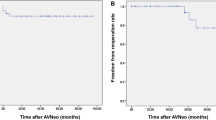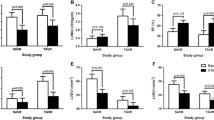Abstract
There are scant data in pediatrics on the optimal timing for aortic valve repair (AVR). This study assesses the midterm response to AVR and possible predictors of poor outcome. From 2001 to 2006, 41 patients had greater than 3-month follow-up after AVR for aortic insufficiency, aortic stenosis, or both. Pre-, peri-, and post-operative data were collected, including demographics and clinical symptoms. Two reviewers measured echocardiographic parameters from the pre-operative and latest follow-up echocardiograms. Ventricular dimensions were indexed to body surface area (z-score). Median age at AVR was 13 years with 83 % having a Ross operation. The average left ventricular end-diastolic dimension pre-op, z-score of +1.3, significantly decreased at last follow-up to a mean z-score of −0.1 (p < 0.001). Similarly the indexed LV mass decreased from +3.9 to +0.5 (p < 0.001). There was no significant correlation between the presence of pre-op symptoms and the presence of post-op LV dilatation, hypertrophy, or dysfunction. In the subset of patients (7/41) with persistent LV dysfunction at last follow-up, there was a significant correlation with pre-op LV dilatation as assessed by both LVEDD (p = 0.02) and LVESD (p = 0.05). Children demonstrate significant reverse remodeling after AVR. Pre-op LV dilatation may predict patients with persistent LV dysfunction post-AVR. Symptoms are less useful in children, suggesting the need for more objective data for functional assessment.

Similar content being viewed by others
References
Otto CM, Lind BK, Kitzman DW, Gersh BJ, Siscovick DS (1999) Association of aortic-valve sclerosis with cardiovascular mortality and morbidity in the elderly. N Engl J Med 341:142–147
Duebener LF, Stierle U, Erasmi A, Bechtel MF, Zurakowski D, Bohm JO, Botha CA, Hemmer W, Rein JG, Sievers HH (2005) Ross procedure and left ventricular mass regression. Circulation 112:I415–I422
Chaliki HP, Mohty D, Avierinos JF, Scott CG, Schaff HV, Tajik AJ, Enriquez-Sarano M (2002) Outcomes after aortic valve replacement in patients with severe aortic regurgitation and markedly reduced left ventricular function. Circulation 106:2687–2693
Bonow RO, Carabello BA, Chatterjee K, de Leon AC, Jr., Faxon DP, Freed MD, Gaasch WH, Lytle BW, Nishimura RA, O’Gara PT, O’Rourke RA, Otto CM, Shah PM, Shanewise JS, Smith SC, Jr., Jacobs AK, Adams CD, Anderson JL, Antman EM, Fuster V, Halperin JL, Hiratzka LF, Hunt SA, Nishimura R, Page RL, Riegel B (2006) ACC/AHA 2006 guidelines for the management of patients with valvular heart disease: a report of the American College of Cardiology/American Heart Association Task Force on Practice Guidelines (writing Committee to Revise the 1998 guidelines for the management of patients with valvular heart disease) developed in collaboration with the Society of Cardiovascular Anesthesiologists endorsed by the Society for Cardiovascular Angiography and Interventions and the Society of Thoracic Surgeons. J Am Coll Cardiol 48:e1–e148
Bonow RO, Carabello BA, Chatterjee K, de Leon AC, Jr., Faxon DP, Freed MD, Gaasch WH, Lytle BW, Nishimura RA, O’Gara PT, O’Rourke RA, Otto CM, Shah PM, Shanewise JS (2008) 2008 focused update incorporated into the ACC/AHA 2006 guidelines for the management of patients with valvular heart disease: a report of the American College of Cardiology/American Heart Association Task Force on Practice Guidelines (Writing Committee to revise the 1998 guidelines for the management of patients with valvular heart disease). Endorsed by the Society of Cardiovascular Anesthesiologists, Society for Cardiovascular Angiography and Interventions, and Society of Thoracic Surgeons. J Am Coll Cardiol 52:e1–e142
Borer JS, Hochreiter C, Herrold EM, Supino P, Aschermann M, Wencker D, Devereux RB, Roman MJ, Szulc M, Kligfield P, Isom OW (1998) Prediction of indications for valve replacement among asymptomatic or minimally symptomatic patients with chronic aortic regurgitation and normal left ventricular performance. Circulation 97:525–534
Brown JW, Ruzmetov M, Vijay P, Bills RG, Turrentine MW (2001) Clinical outcomes and indicators of normalization of left ventricular dimensions after Ross procedure in children. Semin Thorac Cardiovasc Surg 13:28–34
Zoghbi WA, Enriquez-Sarano M, Foster E, Grayburn PA, Kraft CD, Levine RA, Nihoyannopoulos P, Otto CM, Quinones MA, Rakowski H, Stewart WJ, Waggoner A, Weissman NJ (2003) Recommendations for evaluation of the severity of native valvular regurgitation with two-dimensional and Doppler echocardiography. J Am Soc Echocardiogr 16:777–802
Foster BJ, Gao T, Mackie AS, Zemel BS, Ali H, Platt RW, Colan SD (2013) Limitations of expressing left ventricular mass relative to height and to body surface area in children. J Am Soc Echocardiogr 26:410–418
Lieb W, Gona P, Larson MG, Aragam J, Zile MR, Cheng S, Benjamin EJ, Vasan RS (2014) The natural history of left ventricular geometry in the community: clinical correlates and prognostic significance of change in LV geometric pattern. JACC Cardiovasc Imaging 7:870–878
Cheng S, Vasan RS (2011) Advances in the epidemiology of heart failure and left ventricular remodeling. Circulation 124:e516–e519
Bonow RO, Lakatos E, Maron BJ, Epstein SE (1991) Serial long-term assessment of the natural history of asymptomatic patients with chronic aortic regurgitation and normal left ventricular systolic function. Circulation 84:1625–1635
Drazner MH (2004) Left ventricular hypertrophy is more common in black than white hypertensives: is this news? Hypertension 43:1160–1161
Pasquali SK, Cohen MS, Shera D, Wernovsky G, Spray TL, Marino BS (2007) The relationship between neo-aortic root dilation, insufficiency, and reintervention following the Ross procedure in infants, children, and young adults. J Am Coll Cardiol 49:1806–1812
Pizarro R, Bazzino OO, Oberti PF, Falconi ML, Arias AM, Krauss JG, Cagide AM (2011) Prospective validation of the prognostic usefulness of B-type natriuretic peptide in asymptomatic patients with chronic severe aortic regurgitation. J Am Coll Cardiol 58:1705–1714
Author information
Authors and Affiliations
Corresponding author
Ethics declarations
Conflict of interest
The authors declare that they have no conflict of interest.
Rights and permissions
About this article
Cite this article
Singh, A.K., Ungerleider, R.M. & Law, Y.M. The Impact of Aortic Valve Replacement on Left Ventricular Remodeling in Children. Pediatr Cardiol 37, 1022–1027 (2016). https://doi.org/10.1007/s00246-016-1383-x
Received:
Accepted:
Published:
Issue Date:
DOI: https://doi.org/10.1007/s00246-016-1383-x




